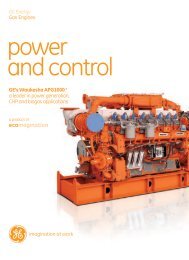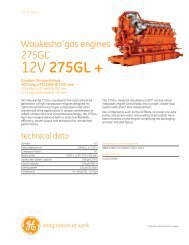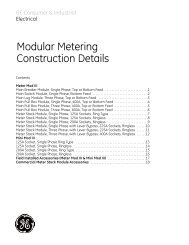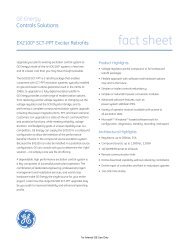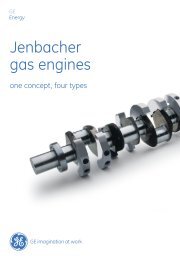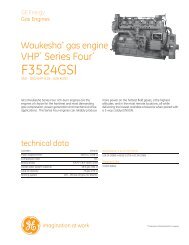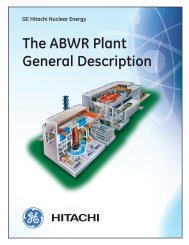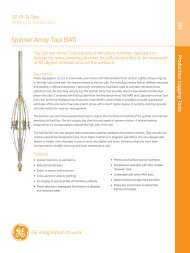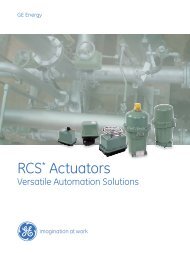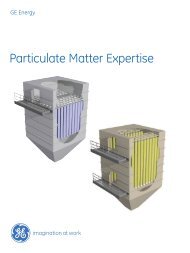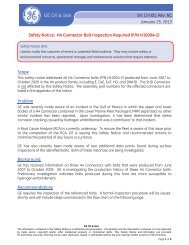Create successful ePaper yourself
Turn your PDF publications into a flip-book with our unique Google optimized e-Paper software.
B A S I C E L E C T R I C I T Y . B A S I C E L E C T R I C I T Y . B A S I C E L E C T R I C I T Y . B A S I C E L E C T R I C I T Y .<br />
[ BASIC ELECTRICITY. ] Technical Information<br />
The Language of Electrical Protection<br />
120 volt circuit. Consisting of one hot wire protected by a single-pole<br />
breaker plus one neutral wire and one ground wire. This type of circuit is<br />
typically used to feed wall outlets, lights and small appliances.<br />
120/240 volt system. A typical electrical system provided by utilities,<br />
consisting of two hot wires and one neutral wire and protected by a twopole<br />
breaker. It is capable of feeding both 120 and 240 volt circuits.<br />
240 volt circuit. Consisting of two hot wires protected by a two-pole<br />
breaker plus one ground wire and frequently one neutral wire. A 240 volt<br />
circuit usually feeds major appliances, such as a range, central air conditioner<br />
or electric dryer.<br />
Amp (A). A measurement of the rate of flow of electrons along a wire.<br />
A simple comparison would be the gallons-per-second measurement used<br />
in plumbing. Watts ÷ volts = amps.<br />
Arc fault circuit interrupter (AFCI). A specialized type of circuit<br />
breaker that stops electricity to a circui to which it is connected when it<br />
detects arc faults caused by broken insulation or frayed extension cords.<br />
AFCIs thus prevent potential fires. The National Electrical Code will<br />
require AFCIs for bedroom circuits beginning in 2002.<br />
Branch circuit breaker. A circuit breaker protecting a single circuit in<br />
a home. Single-pole branch breakers typically protect 120 volt circuits and<br />
come in ratings of 15 to 50 amps. Two-pole breakers are usually used for<br />
circuits that feed major appliances and, for home use, are available in<br />
ratings up to 125 amps.<br />
Circuit. The path electricity follows as it moves along a conductor.<br />
Branch circuits distribute power to the parts of a home where it’s needed.<br />
Circuit breaker. A resettable device that automatically stops electrical<br />
flow in a circuit when an overload or short circuit occurs. Like a fuse, a<br />
circuit breaker (located in a load center) protects a home’s wiring from<br />
becoming overheated and possibly causing a fire. Also see branch circuit<br />
breakers and main circuit breakers.<br />
Conductor. A material capable of carrying electricity’s energy.<br />
Current. The rate of flow of electrons through a conductor, measured in amps.<br />
Electron. An invisible particle of negatively charged matter that moves<br />
at the speed of light through an electrical circuit.<br />
Fuse. A safety device that, like a circuit breaker, automatically stops<br />
electrical flow in a circuit when an overload or short circuit occurs.<br />
Ground. Refers literally to earth, which has an electrical potential<br />
(voltage) of zero.<br />
Ground fault circuit interrupter (GFCI). A safety device that senses<br />
shock hazard to a far greater degree than circuit breakers or fuses, and<br />
automatically stops electrical flow to a circuit.<br />
Ground wire. The conductor used to connect the electrical equipment to<br />
earth at the service entrance point, minimizing the potential for electrical<br />
shock. Clad in green insulation or unclad.<br />
Hot wire. The conductor that carries electricity from the utility to a load<br />
center, or from a branch circuit breaker or fuse to a receptacle or appliance.<br />
It is normally clad in red or black insulation. Also see neutral wire and<br />
ground wire.<br />
Insulation. A non-conductive covering that protects wires and other<br />
conductors of electricity.<br />
Kilowatt (kw). One thousand watts. A kilowatt-hour is the measurement<br />
most utilities use to measure electrical consumption, indicating how<br />
many kilowatts are consumed for a full hour during a billing cycle.<br />
Knockouts. Tabs that can be removed to make openings for wires<br />
and/or circuit breakers in load centers and other electrical equipment.<br />
Load center. A home’s circuit breaker box. It divides the power into various<br />
circuits for distribution throughout the home. Installed branch circuit<br />
breakers provide short circuit, overcurrent and, sometimes, ground fault<br />
and arc fault protection.<br />
Main circuit breaker. A circuit breaker that permits you to shut off<br />
electricity to all the circuits in the home. It may be located in the load<br />
center or a separate enclosure. Main breakers are typically rated anywhere<br />
between 40 and 225 amps.<br />
National Electrical Code (NEC). Recommendations dealing with safe<br />
electrical practices adopted by the National Fire Protection Association.<br />
These recommendations are used by federal, state and local governments<br />
to help protect life and property.<br />
Neutral wire. The conductor that carries current from an outlet back to<br />
the load center neutral. It is always clad in white insulation. Also see hot<br />
wire and ground wire.<br />
Overload. A condition that results when a circuit is carrying more<br />
amperage than it was designed to handle. If not properly protected by a<br />
circuit breaker or fuse, overloads will cause conductors to heat up, often<br />
melting the conductor’s insulation. Fires can result.<br />
Safety switch. A device most commonly used for manually turning a<br />
circuit on and off.<br />
Service entrance. The point where electricity enters a home.<br />
Short circuit. A temporary, accidental connection between exposed live<br />
wires or other parts of the electrical system. Short circuits will cause<br />
excessive amounts of curren to flow, possibly causing a fire or explosion<br />
is not properly protected by a circuit breaker.<br />
System ground. A circuit that connects all metal enclosures and electrical<br />
devices that need grounding to ground, thereby minimizing the possibility<br />
of electrical shock.<br />
Transformer. A device that increases or decreases voltage.<br />
Underwriters Laboratories (UL). An independent testing agency that<br />
examines (among other products) electrical equipment and components<br />
for possible safety hazards. Only those appliances, electrical devices and<br />
outlets that bear a UL label should be used in the home.<br />
Utility service meter. A device that measures electricity usage.<br />
Volt (V). A measure of electrical potential. If compared to a plumbing<br />
system, voltage would resemble water pressure. Watts ÷ amps = volts.<br />
Watt (W). A measure of the power an electrical device consumes.<br />
Volts X amps = watts.<br />
45




